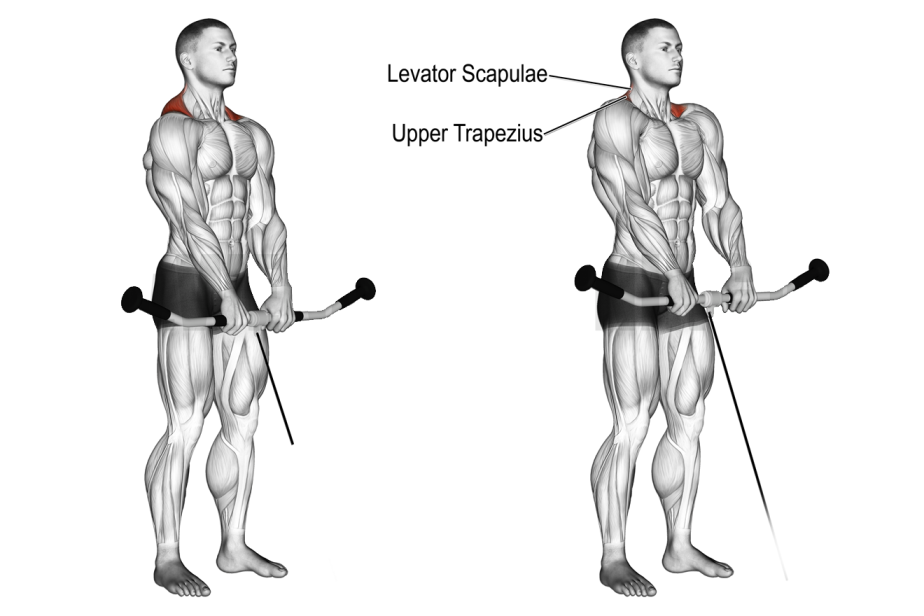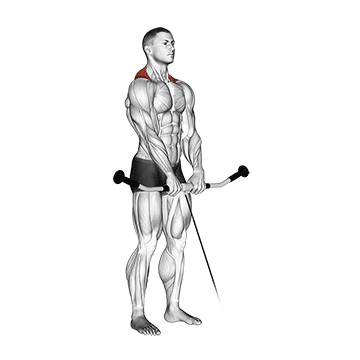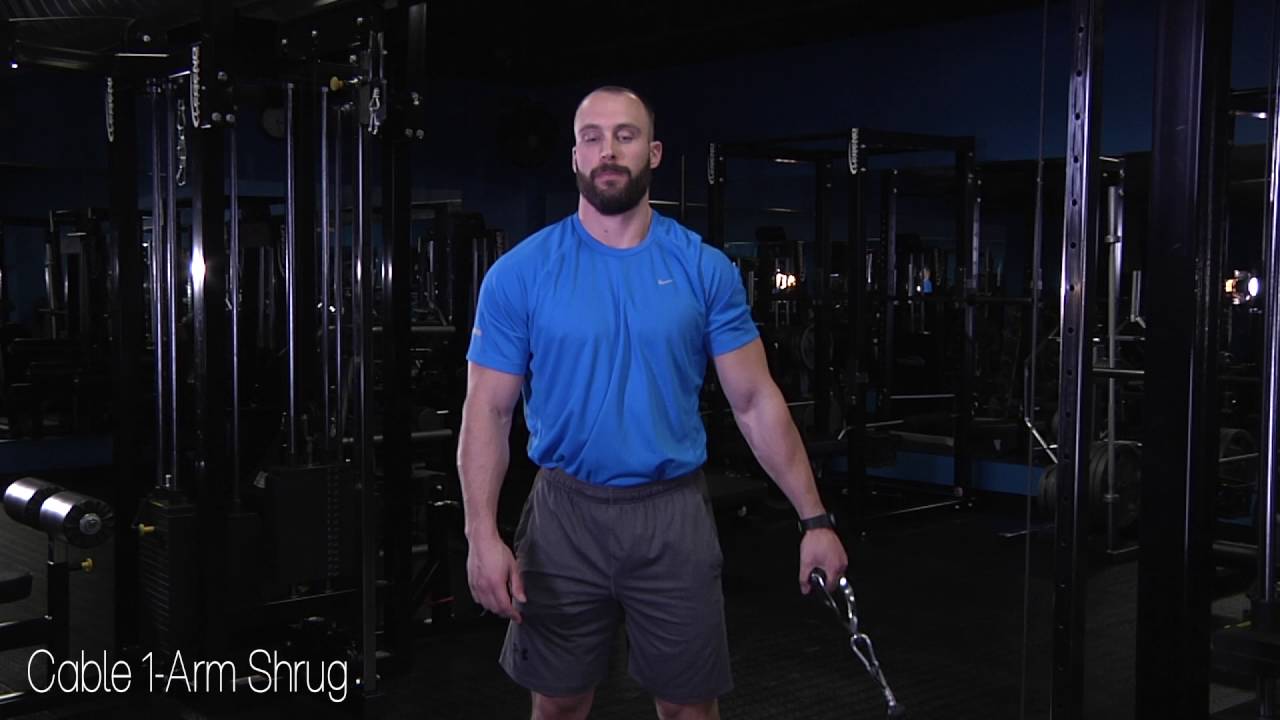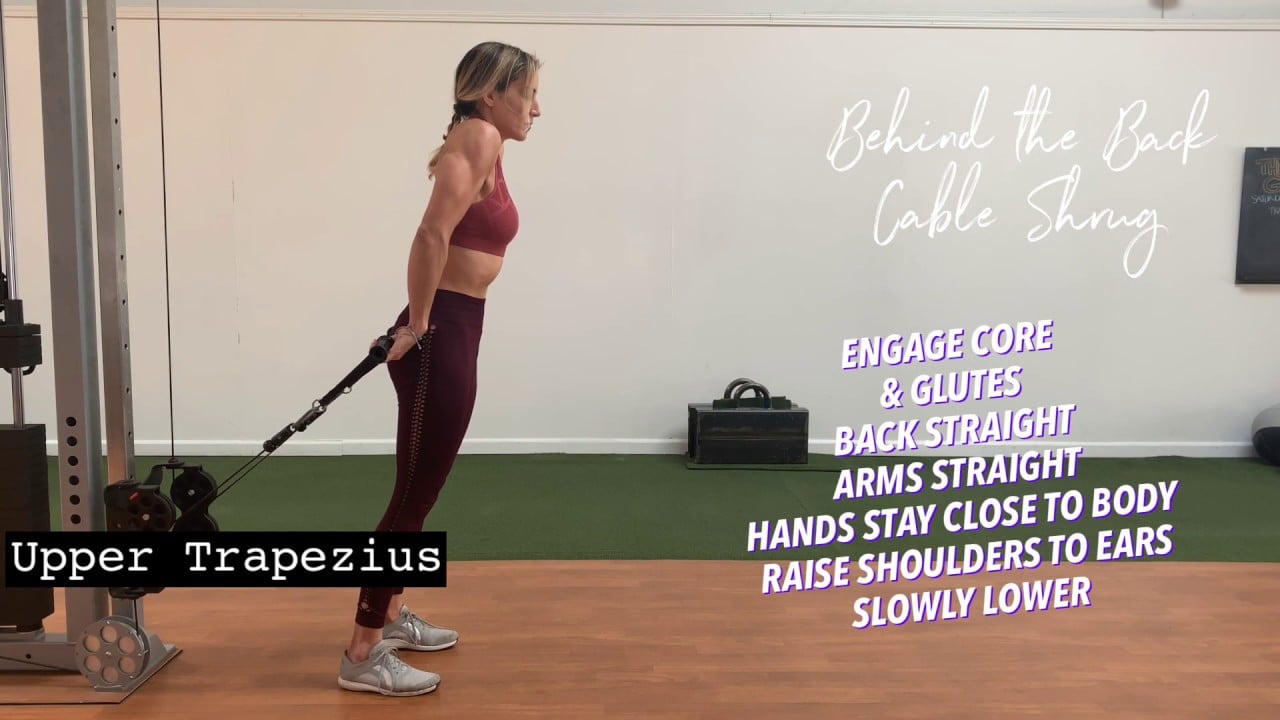The cable shrug is an isolation trap exercise that mainly trains the upper trapezius muscles. It is a frontal plane movement that involves scapular elevation (raising the shoulder girdle directly toward the ears).
In contrast to conventional dumbbell or barbell shrugs, the cable variation offers a consistent tension and a strong trap stimulus that can break through plateaus and stimulate new growth.
The pulley system often provides a smoother, more controlled path of motion and allows for lifting heavy weights. For this reason, it’s my favorite trap exercise.
Want to take your gains to the next level? Discover your daily calorie needs with our free TDEE calculator

Cable Shrug Muscles Worked
- Primary Muscle: Upper Trapezius
- Secondary Muscles: Levator scapulae, Rhomboids, Middle Trapezius, Rotator cuff muscles and Forearms (grip strength)
- The stabiliser muscles that work during a shrug are the core and erector spinae.

The trapezius is a diamond-shaped muscle extending from the base of your skull to the middle of your back and across your shoulders. It’s divided into three regions:
- Upper traps: Responsible for shoulder elevation (the primary movement in shrugs)
- Middle traps: Scapular retraction
- Lower traps: Scapular depression and downward rotation
How To Do a Cable Shrug
- Select a straight bar or rope attached to the low pulley of the cable machine.
- Start with a conservative weight you know you can control for 10-15 strict repetitions. You can always increase it later.
- Stand facing the cable machine, feet shoulder-width apart, about 6-12 inches away from the pulley.
- You can experiment with distance to find the sweet spot where the cable doesn’t hit your legs but still allows a good vertical pull.
- Grasp the bar with an overhand grip, hands slightly wider than shoulder width. Your palms will face your body. If using a rope, hold the ends with a neutral grip (palms facing each other).
- Stand tall with a straight back, chest lifted, and shoulders relaxed and depressed (pulled slightly downwards). Your core should be lightly engaged.
- At the very top of the movement, squeeze your upper trapezius muscles hard. Hold this peak contraction for a deliberate 1-2 second count.
- Slowly and with complete control, lower your shoulders back down to the starting position.
- Repeat for the desired number of reps, typically 8-12, to build muscle.
Tips and Form
- Keep your spine neutral (straight back, head looking forward or slightly down). Avoid rounding your back or craning your neck.
- Engage your core and glutes slightly to avoid leaning forward or arching your back.
- Elevate your shoulder blades directly upward. Avoid rolling the shoulders—it’s dangerous for your shoulder joints.
- Don’t just drop the weight—control the descent over 1.5–2 seconds. This phase builds muscle just as much (if not more) than the lift.
- Form always comes first. Beginners should use moderate weight and prioritise perfect execution. You can go heavier later, but form should never break.
- Keep arms locked straight. Think of your arms as ropes connecting the weight to your shoulders. The movement comes solely from the shoulder girdle elevating.
- Exhale as you shrug up (concentric phase), inhale as you lower the weight (eccentric phase).
- Lift the weight smoothly and under control to the highest point you can comfortably reach (full scapular elevation). Lower the weight slowly and keep it under control, resisting the pull of the cable. Do NOT use momentum to jerk the weight up or let it drop quickly.
- Aim for 3–4 sets of 8–10 repetitions to start. As you build up your shoulder strength, you can increase the number of reps. Over time, try working up to do 4–5 sets of 20 repetitions, 2–3 times a week.
- While a slightly wider than shoulder-width grip on a straight bar is standard, try a slightly narrower grip or using a rope attachment. Different hand positions can alter the feel of the exercise and may help you find a stronger connection with your traps.

Best Variations Of Cable Shrugs
The cable shrugs can be done differently to suit your fitness level.
If you’re new to doing cable shoulder shrugs, you may want to make the exercise easier by doing a few things differently.
- One way to solve this problem is to do one-arm cable shrugs.
- Another is to use a lighter weight.
If you are looking for a more advanced variation to stimulate different muscle fibers in the trap, then try
- A cable shrug behind the back.
- A cable side shrug.
- You could make it more challenging by using heavier weights.
1. One-Arm Cable Shrug
It’s common for one side of our body to be stronger or more developed than the other. The one-arm shrug forces each trap muscle to work equally without the stronger side compensating for the weaker one.
This helps you identify and work to correct those trap imbalances over time.
Holding a weight on one side engages your core, particularly the obliques and spinal stabilisers, to prevent leaning or rotation. This functional movement enhances core strength and stability.
2. Behind The Back Cable Shrugs
Behind-the-back cable shrugs are variations performed by holding the bar behind your thighs. They help strengthen the upper and middle trap muscles.
For complete trap development, include both the front and reverse versions in your training regimen.
Having the bar behind you helps keep your shoulders pulled up and back rather than rounded forward.
Know More Body Fat %: Use Our Free Body Fat Calculator
Here are many other exercises to train the upper trap.
- Barbell Shrug
- Incline Dumbbell Shrug
- Smith Machine Shrug
- Dumbbell Shrug
- Behind The Back Barbell Shrugs

Manish is a NASM-certified fitness and nutrition coach with over 10 years of experience in weight lifting and fat loss fitness coaching. He specializes in gym-based training and has a lot of knowledge about exercise, lifting technique, biomechanics, and more.
Through “Fit Life Regime,” he generously shares the insights he’s gained over a decade in the field. His goal is to equip others with the knowledge to start their own fitness journey.


